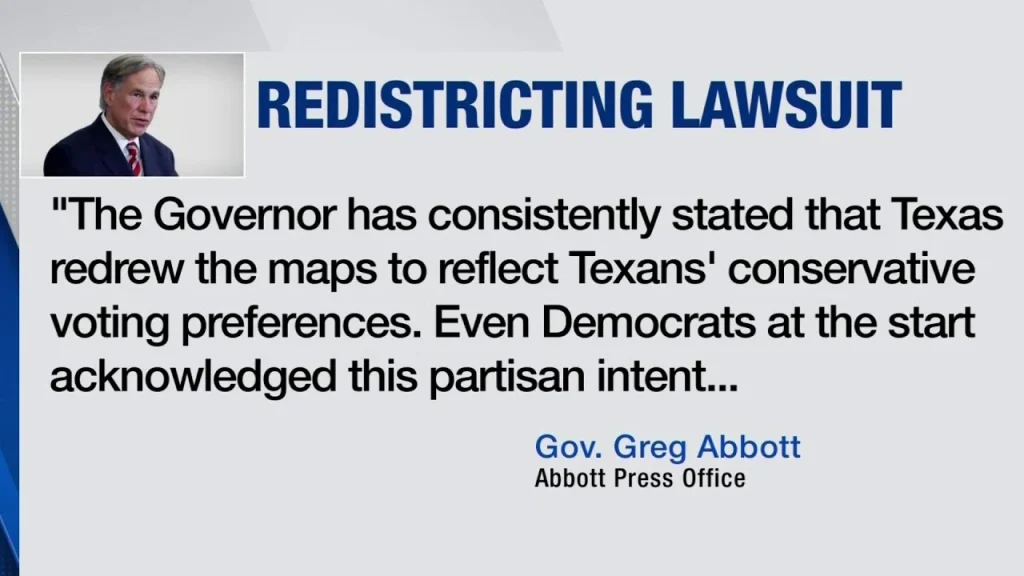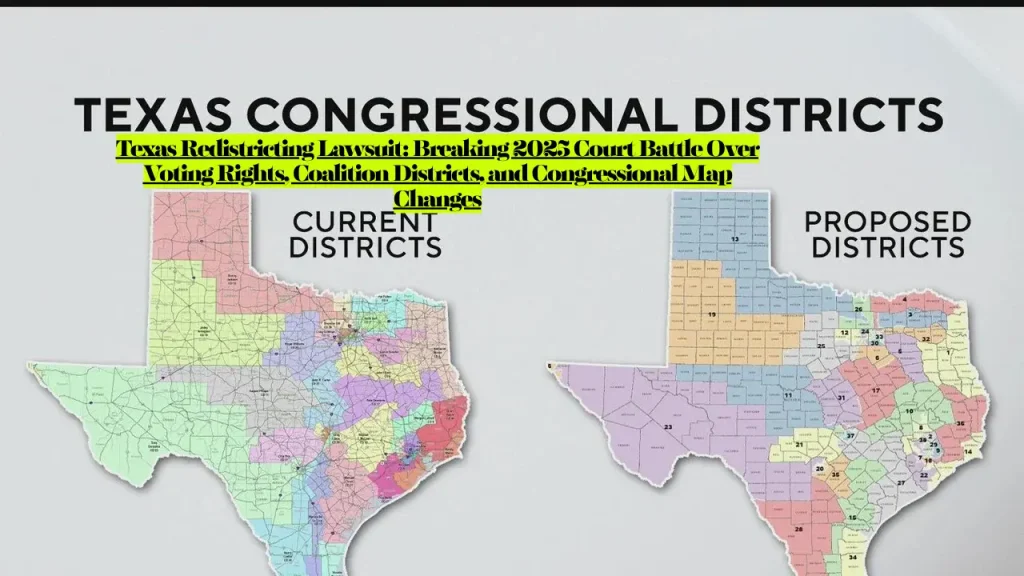Texas Redistricting Lawsuit, Breaking 2025 Court Battle Over Voting Rights, Coalition Districts, and Congressional Map Changes
Texas lawmakers redrew congressional districts mid-decade in 2025 to add five Republican seats, triggering federal lawsuits alleging racial discrimination against Black and Hispanic voters. A three-judge federal panel in El Paso heard arguments from October 1-10, 2025, with post-hearing briefs due October 17. The Department of Justice warned that four districts—TX-9, TX-18, TX-29, and TX-33—violated constitutional protections by combining Black and Hispanic voters into coalition districts. Governor Greg Abbott signed the new map into law on August 29, 2025, after Democrats walked out of special legislative sessions.
The 2026 midterm filing deadline looms December 8, 2025. Voters in affected districts face uncertainty about which map applies.
What Is the Texas Redistricting Lawsuit About?
The consolidated case League of United Latin American Citizens v. Abbott challenges Texas’s 2025 congressional redistricting as unconstitutional racial gerrymandering and violation of the Voting Rights Act. Civil rights groups including LULAC, Mexican American Legal Defense and Educational Fund (MALDEF), Texas NAACP, Fair Maps Texas Action Committee, and individual voters filed lawsuits seeking to block the new maps.
Texas initially cited DOJ concerns about coalition districts as justification, then switched arguments in court to claim purely partisan redistricting—which the U.S. Supreme Court has allowed. Legal experts called this reversal unprecedented, with constitutional law professor Justin Levitt describing the DOJ’s letter as “sloppily dashed-off work” that misinterpreted the 2024 Petteway ruling.

Who Filed the Lawsuit and What Are the Legal Claims?
On October 18, 2021, Latino civil rights organizations and Texas voters filed the original LULAC lawsuit challenging post-2020 census maps. The case consolidated with six other challenges: Fair Maps Texas Action Committee v. Abbott, Texas State Conference of NAACP v. Abbott, Wilson v. Texas, Brooks v. Abbott, Mexican American Legislative Caucus v. Texas, and Voto Latino v. Scott.
Primary legal claims:
- Section 2 Voting Rights Act violations: Texas congressional and state House plans dilute Latino and Black voting strength by eliminating minority opportunity districts and packing voters of color into fewer seats
- 14th Amendment Equal Protection violations: Unconstitutional racial gerrymandering targeting Black and Hispanic voters
- 15th Amendment violations: Denying voting rights based on race
- Intent to discriminate: Maps enacted with intent to discriminate against minority voters
After Texas passed House Bill 4 in August 2025, plaintiffs filed supplemental complaints and motions for preliminary injunction to block the 2026 elections under the new map.
Which Congressional Districts Are Affected?
The DOJ letter flagged four coalition districts where multiple racial groups combined to form majorities: Districts 9, 18, 29 (Houston area), and 33 (Fort Worth area). The 2025 redistricting drastically altered these seats.
Houston Area Districts
District 9 (Rep. Al Green): Previously a multiracial district (45% Black, 25% Hispanic, 18% white, 9% Asian voters), the new map retains just 2% of Green’s current constituents and adds conservative east Harris County areas, flipping from D+48 to R+11. The redrawn district adds majority-white Liberty County, diluting Latino voting strength in east Houston.
District 18 (vacant after Rep. Sylvester Turner’s death): Redrawn as just over half Black to create a single-race majority district instead of a coalition district. The new 18th could see an incumbent-on-incumbent primary if Al Green runs there, where 65% of his current constituents now reside.
District 29 (Rep. Sylvia Garcia): The district loses its Hispanic majority, becoming 43% Hispanic, 33% Black, 18% white—no longer allowing Latino voters to elect candidates of choice.
District 7 (Rep. Lizzie Fletcher): Became slightly bluer and remains Solid Democratic.
Dallas/Fort Worth Area Districts
District 33 (Rep. Marc Veasey): Redrawn entirely—Fort Worth removed from the district, with white voter share rising from 23% to over 35%. Rep. Marc Veasey was drawn out of his district.
District 32 (Rep. Julie Johnson): The proposed map could turn this North Texas district Republican by packing more Democratic voters into nearby districts.
Other Targeted Districts
The map targets five Democratic seats: Marc Veasey (33), Greg Casar (35), Lloyd Doggett (37), Julie Johnson (32), and Al Green (9). Texas goes from having nine multiracial coalition districts to four, creating two majority Black districts (18 and 30) instead.
What Voting Rights Are at Stake?
The 2024 Fifth Circuit Petteway ruling eliminated coalition district protections, requiring a single racial group to constitute a majority before bringing Voting Rights Act claims. Legal experts dispute whether this ruling mandates states to dismantle existing coalition districts, with University of Michigan Law School professor Ellen Katz stating: “Nothing in this decision suggests, much less holds, that the VRA prohibits the very existence of coalition districts”.
At stake for Texas voters:
- Minority representation: Four Houston-area districts that previously allowed minority voters to elect candidates of choice reduced to three
- Coalition voting power: Historically, Black and Hispanic voters joined forces since the 1987 Baytown case (Campos v. City of Baytown) to challenge voting discrimination
- Electoral influence: Texas is 40% white, yet white voters would control over 73% of congressional seats under the new map
- Partisan balance: Republicans could gain five seats, increasing their delegation from 25 to potentially 30 of Texas’s 38 congressional seats
Before the Supreme Court rules on Louisiana voting rights case Callais, which could strip most Voting Rights Act protections for voters of color, Texas and counties may swiftly redraw maps to strengthen Republican majorities.

What Are the Most Recent Court Developments?
October 1-10, 2025: Three-judge panel (U.S. District Judges David Guaderrama and Jeff Brown, plus 5th Circuit Judge Jerry Smith) held nine-day preliminary injunction hearing in El Paso federal court.
October 17, 2025 deadline: Post-hearing briefs due.
Court testimony revelations: Adam Kincaid, National Republican Redistricting Trust director hired by the RNC to draw the map, testified he sent the map to the Texas Legislature three days before hearings. Senate redistricting chair Phil King initially told Democrats he didn’t know who drew the map, later admitting he met with Kincaid three times and asked if Republicans could gain five seats. Judge Jerry Smith grew frustrated with King’s evasive answers, demanding yes-or-no responses.
Expert testimony: University of Houston political scientist Richard Murray testified Republicans “surgically assaulted and dismembered” minority-controlled districts while leaving white-controlled Democratic districts untouched.
Earlier proceedings: Original trial on 2021 maps held May 21-June 11, 2025. Court stayed post-trial briefing in August 2025 pending Supreme Court resolution of Louisiana v. Callais and potential new congressional map.
What Is the Current Lawsuit Status?
The three-judge panel will rule whether Texas can use the new map for 2026 midterm elections or must revert to 2021 maps used in the last two elections. Unlike typical federal cases that go through district courts and circuit appeals, voting rights lawsuits can only be appealed directly to the U.S. Supreme Court.
Timeline pressures:
- November 8, 2025: Filing period begins for 2026 Texas congressional candidates
- December 8, 2025: Filing deadline for 2026 midterms, forcing Democratic incumbents in redrawn districts to decide whether to run in new districts, face primaries against colleagues, retire, or seek other offices
- November 4, 2025: Special election for vacant District 18 under old district lines
The DOJ moved to dismiss its December 2021 claims on March 6, 2025, after the Trump administration reversed the Biden DOJ’s position.
How Do the New Maps Impact Voters?
Many Texas voters will vote in congressional districts with different political leanings or demographic majorities in 2026 midterms unless courts block the maps.
Redistricting techniques used:
- Packing: Concentrating Democratic voters into fewer districts in Dallas and Houston areas to leave more Republican voters in neighboring districts
- Cracking: Splitting Hays County (52.1% voted for Kamala Harris in 2024) into two Republican districts—21st and 27th
- Surgical dismemberment: Targeting specific minority-controlled districts while preserving white-controlled Democratic seats
Incumbent matchups created: The map forces potential Democratic primaries between Marc Veasey/Julie Johnson (District 33) and complications in the Houston area where three blue seats compress current four-seat delegation.
Republicans bet Texas continues rightward shift. Democrats must flip six Republican seats (instead of three) to retake House majority after losing Texas seats.
What Recent Developments Have Occurred?
President Trump used unprecedented “sue and settle” strategy, with the DOJ sending Abbott and Attorney General Ken Paxton a letter providing legal justification for mid-decade redistricting. Trump stated explicitly partisan motivations: “We have an opportunity in Texas to pick up five seats”.
After Texas passed its redistricting map, California Governor Gavin Newsom signed measures asking voters to approve five new Democratic-favoring districts in direct response. Other states considering mid-decade redistricting include Indiana, Missouri, Utah, Illinois, New York, and Maryland.
Critics including Mexican American Legal Defense and Educational Fund president Thomas Saenz called the coordination between Trump’s DOJ and Texas “a disturbing pattern of collusion that should alarm everyone who believes in democratic processes”.
Democratic walkout tactics: Texas Democrats fled to deny quorum during the first special session in July 2025. Abbott threatened court action to declare seats vacant, and the Texas House voted 85-6 to arrest absent legislators. Most Democrats returned after the special session expired; those who returned were required to sign forms agreeing to police escort at all times.
How Does This Compare to Previous Texas Redistricting Battles?
Federal courts have found at least one Texas map violated the Voting Rights Act every decade since 1965. The 2003 mid-decade redistricting forced nearly a dozen Texas Democrats to confront retirement, district changes, or primaries against colleagues.
In the 2006 LULAC v. Perry case, the U.S. Supreme Court found District 23 violated Section 2 of the Voting Rights Act, requiring changes to five congressional districts.
The 1987 Baytown case established coalition district precedent when Tony Campos sued successfully to create a district where Black and Hispanic voters combined exceeded 50%. The 2024 Petteway ruling reversed 37 years of coalition district protections.
What Are the Next Steps?
Immediate actions:
- Watch for court ruling: The three-judge panel indicated it intends to rule before November candidate filing period
- Monitor appeals: Any ruling can be appealed directly to U.S. Supreme Court
- Track related cases: Supreme Court expected to rule in Louisiana case Callais, which could eliminate most Voting Rights Act protections for voters of color
For affected voters:
- Verify your congressional district at the Texas Secretary of State’s website or use district lookup tools
- Contact your current representative about redistricting impact
- Monitor court decisions through official court websites and news sources
- Prepare for potential district changes before November 2026 elections
For candidates: December 8, 2025 filing deadline creates pressure to decide quickly which district to run in.
What Voting Rights Laws Apply?
Section 2 of the Voting Rights Act (1965): Prohibits states from engaging in voting practices that dilute electoral power of voters of color, including packing them into single districts or diffusing them throughout multiple districts.
14th Amendment Equal Protection Clause: Protects against racial discrimination in voting maps.
15th Amendment: Prohibits denying voting rights based on race.
Supreme Court precedents:
- Thornburg v. Gingles (1986): Established that groups must be “sufficiently large and geographically compact to constitute a majority in a single-member district” to bring Voting Rights Act claims
- Petteway v. Galveston County (2024): Fifth Circuit en banc ruling that individual racial groups must constitute district majorities to bring voting rights challenges
What Are the Potential Outcomes?
Possible court decisions:
- Block the 2025 map: Force Texas to use 2021 maps for 2026 midterms while litigation continues
- Allow the new map: Let 2025 redistricting proceed for 2026 elections
- Order remedial map: Direct Texas to create new districts complying with Voting Rights Act, potentially with court-drawn interim plans
Political consequences:
- If Texas map stands, Democrats need six Republican flips (not three) to retake House majority
- California’s proposed counter-redistricting could add five Democratic seats
- Other states may pursue mid-decade redistricting, creating national redistricting arms race
Long-term implications: If the Supreme Court weakens Voting Rights Act protections in pending Louisiana case, Texas and other states could redraw maps again to maximize partisan advantage.
Frequently Asked Questions
What is the Texas redistricting lawsuit about?
The consolidated case League of United Latin American Citizens v. Abbott challenges Texas’s 2025 mid-decade congressional redistricting as unconstitutional racial gerrymandering. Civil rights groups argue lawmakers illegally relied on race and drew maps violating Black and Hispanic voters’ equal protection rights.
What are the most recent court rulings in the Texas redistricting case?
A three-judge federal panel held a nine-day preliminary injunction hearing October 1-10, 2025, with post-hearing briefs due October 17. The court must rule before November 8 candidate filing deadline.
Which Texas congressional districts are affected by redistricting?
The DOJ flagged Districts 9, 18, 29 (Houston area), and 33 (Fort Worth) as unconstitutional coalition districts. The 2025 map targets five Democratic seats: Districts 9, 32, 33, 35, and 37.
How do the new Texas redistricting maps impact my vote?
Many voters will be in districts with different political leanings or demographic majorities. Minority voters in four Houston-area districts that previously elected candidates of choice are reduced to three districts. Check your district using official Texas election resources.
What voting rights are at stake in the Texas redistricting lawsuit?
Coalition district protections that allowed Black and Hispanic voters to combine forces for 37 years were eliminated by the 2024 Petteway ruling. Under the new map, white voters would control over 73% of Texas congressional seats despite being 40% of the population.
Can Texas use the new congressional map for 2026 elections?
The three-judge panel will decide whether Texas can use the 2025 map or must revert to 2021 districts. Court ruling expected before November 8, 2025 filing deadline.
What should Texas voters do about redistricting?
Verify your congressional district at the Texas Secretary of State website. Monitor court decisions through official sources. Contact representatives about redistricting impact. Prepare for potential district changes before November 2026 elections.
Legal Disclaimer: This information is for educational purposes only and does not constitute legal advice. Redistricting details, legal claims, court rulings, case status, and voting rights implications may vary based on individual circumstances and jurisdiction. Consult official court documents, review case filings independently, contact election officials for district-specific information, and contact an attorney for specific questions about voting rights or legal implications.
Additional Resources
- Texas Secretary of State – Elections Division
- U.S. District Court Western District of Texas – Case Filings
- The American Redistricting Project – LULAC v. Abbott
- League of Women Voters – Texas Redistricting
Related Articles
- Questions to Ask a Divorce Lawyer in Texas
- Houston Deportation Defense Attorney
- Texas Identity Theft Enforcement and Protection Act
About the Author

Sarah Klein, JD, is a licensed attorney and legal content strategist with over 12 years of experience across civil, criminal, family, and regulatory law. At All About Lawyer, she covers a wide range of legal topics — from high-profile lawsuits and courtroom stories to state traffic laws and everyday legal questions — all with a focus on accuracy, clarity, and public understanding.
Her writing blends real legal insight with plain-English explanations, helping readers stay informed and legally aware.
Read more about Sarah
